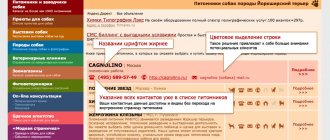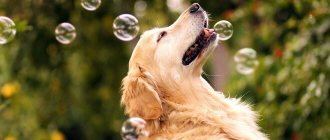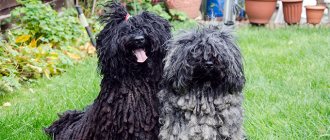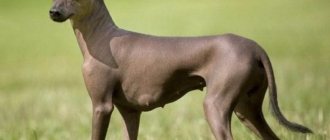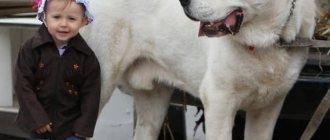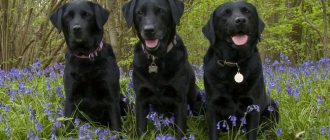Home » Dog Breeds
Classification Origin: UK
Class: according to FCI – group 8 Retrievers, Water Dogs, Spaniels, 1st section Retrievers with working tests
Use: gun dog
Color: golden or cream in any shade except mahogany and mahogany. White hairs on the chest are acceptable
Dimensions: male 56-61 cm, female 51-56 cm
Weight: males: 26-41.5 kg. Females: 25-37 kg
Lifespan: 10-12 years
For many years, a very romantic story was used as a theory about the origin of the Golden Retriever, which told about the origin of the breed from circus dogs imported from the Caucasus.
The Golden Retriever is a gorgeous breed that amazes with its intelligence.
- 2 Psychology
- 3 Application
- 4 How to choose a dog
- 5 Features of care
- 6 Combing
- 7 Walking
- 8 Food
- 9 Health
- 10 Characteristic diseases
- 11 Vaccinations
- 12 Mating
History of the breed
It was believed that dog breeding was carried out on the territory of the Guisachan Estate, the British county of Ivernessshire, acquired in the middle of the last century by Lord Tweedmouth, who was engaged in purebred breeding of golden retrievers.
Thus, how the Russian Circus Dog appeared. The breed even took part in the 1913, 14 and 15 Crufts shows. After the death of the owner, these dogs were forgotten.
The history of the breed, which had romantic roots, was completely refuted by researchers
Later, in 1914, an article entitled "The Russian or Yellow Retriever", describing the origin and breeding of circus dogs, was published in Country Life by Arthur Croxton-Smith.
Over time, this article was crushed by the president of the Club of England, Elma Stoneks, and in 1952, the 6th Earl of Ilchester published an article describing the breeding work carried out by his uncle.
It described many breeds that were used to create the Golden Retriever. The history of the nursery dates back to 1835; the following were used in breeding work:
- Irish Setter
- Water Retriever
- Flat-Coated Retriever
- Labrador
- Bloodhound
Official recognition of the breed occurred in 1913.
Straight-haired (Flat-Coadet)
Flat retrievers are actively gaining popularity, trying to catch up with Labradors. The dogs were bred in Britain at the end of the 18th century, but the breed was finally formed in the mid-19th century.
Like their brothers, Flats are waterfowl hunters. At first, the animals worked together with the Spaniels, catching birds, but later they only began to bring shot prey.
The first individuals had wavy hair; at exhibitions the breed received the name “Wavy-haired”, but the wool did not have the required density and water-repellent properties. Therefore, other breeds were mixed into the blood to improve the protective properties of the cover.
This is a harmoniously built, strong dog with a rectangular, streamlined body. The average size at the withers is 58 cm, maximum weight is 35 kg . The calling card of these Retrievers is their straight, medium-length coat, soft and silky. Color: liver, red-brown.
This breed is the fastest in the group. Flets have a quick reaction, so in addition to hunting, they show good results in agility, freestyle, and other types of dog sports.
Animals are serious and reserved with others, but in the family they are active and loving. They do not like to be commanded, but are ready to serve people faithfully. Like all Retrievers, they need education, training and training in working qualities. The average cost is 35,000 rubles.
Psychology
Golden Retrievers are calm and kind dogs , playful, so they get along well with everyone at home.
They are intelligent and do not tend to bark much. There are no notes of dominance, like in Hovawarts , which allows peaceful coexistence with domestic animals.
Very receptive and delicate dogs. Good nature and devotion, patience and adoration for people, combined with indomitable energy and love for fetching, make him an excellent playmate.
An excellent character will allow the Golden to become a true friend for all family members
Thanks to its developed intelligence, the dog is highly trainable and capable of achieving excellent results. The use of this breed is associated with these qualities.
Kinds
American and European breeders have not come to a consensus regarding the golden standard. Each side insisted that it was right, so it was decided to divide the breed into 2 types - American and European.
Outwardly they have many similarities, but there are also differences. Firstly, a representative of each of these types is strong, strong and harmoniously built. Secondly, he is kind and not at all vindictive. But let's discuss the differences:
- European retriever. The dog's coat has a beautiful creamy shade with a golden tint. Soft to the touch. His croup is denser, and his legs are short. The head is large, the frontal line is well defined. Good-natured and not at all evil.
- American Retriever. The main difference between the representative of the breed is the beautiful bronze shade of the fur. The American has longer legs and a moderate croup. Lean physique. Small head.
The dogs are practically no different in character. Both are affectionate, cheerful and very responsible.
Application
In the modern world, golden retrievers are rarely used for their main purpose - hunting. Despite this, they remain excellent assistants for serving game and working on a blood trail.
The hunter's instinct, as can be seen in the photo, is still present in the breed
Now the main “working specialties” of golden retrievers are:
- Search for drugs and explosives at customs
- Guide
- Assistant for people with disabilities
- Rescue operations of the Ministry of Emergency Situations
- Therapist
- Film and commercial actors
Specially trained Golden Retrievers are used as companions for children with mental disorders in boarding schools and shelters. Ideal friends for the elderly and children.
However, despite all the excellent qualities, the dog is practically unsuitable as a guard, since it will not attack strangers, but, on the contrary, will try to make friends with them.
Amstaff , Tosa Inu , American Pit Bull Terrier , as well as other fighting dogs are better suited .
Character
The Golden Retriever dog is incredibly kind and charming. She easily wins over people and even animals; she loves when everyone’s eyes are turned to her. Most experts call this breed an ideal companion. It's hard to disagree with this.
Anyone can get along with him: a small child, an old man, a gentle woman or a brutal man. It is almost impossible to be angry with such a dog. He always strives to please his loved ones and bring a smile to their faces. He is friendly and responsive. Very responsible. Will never leave a person in trouble.
There are many known cases of goldens saving people, even pets. Sometimes it is not possible to promptly call for help, but such a dog never loses its vigilance! If an accident happens to her owner, she will feel it and rush to the rescue.
He approaches “business” fearlessly, responsibly and even with curiosity. By the way, she has the latter quality in abundance. The animal likes to learn new things about the world, meet different people, delight everyone with its incredible charm and just have fun.
It never lies down during the day, like a basset hound, for example. Strives to find interesting objects and keep himself busy with something. But the favorite pastime of a gorgeous dog is to play with its owner. She becomes strongly attached to people who do not skimp on kindness and love, and in return always gives them her tenderness.
The Golden Retriever is a very gentle animal. Watching him rub against his owner's leg or rest his muzzle on his owner's lap in hopes of getting the top of his head scratched is touching and entertaining. It extremely rarely experiences anger, one might say almost never.
Not prone to suspicion. Prefers to maintain friendly rather than conflictual relationships with living beings. Gets along well with other animals in the house, even dogs and cats. But, due to natural goodwill and lack of malice, he himself often becomes a victim of bullies.
Golden can repel an ill-wisher if he actively protests against his company. He may even bite in defense of himself, but it is a mistake to think that anger is inherent in him by nature.
How to choose a dog
First of all, when choosing a puppy, you should take into account its origin, since the baby receives all the main traits of both character and appearance from his parents and closest relatives.
Buying from reputable breeders who can show you your potential pet's mom, dad, and grandparents greatly increases your chances of getting a great friend.
A competent approach to choosing a puppy is very important
First of all, you need to pay attention to:
- parental behavior - they should not be aggressive;
- healthy appearance of the puppy;
- no external defects.
The puppy needs to be fully examined. Bright and lively eyes looking at you clearly, clean skin without wounds and dandruff, clean and healthy ears, pink gums and white teeth - these are what you should pay attention to. These are signs that your puppy is in good health.
In terms of exterior, when choosing a Golden, pay attention to the following indicators:
- Good skull width
- Well-defined, deep muzzle
- Correct bite
- Ears of moderate length with correct fit
- Compact body with good chest
- Wide pelvis
- Dark eyes
- Nose and paw pads black
As for character, the puppy should be inquisitive, not show cowardice, and be active
If you are hoping to purchase a future champion, you should pay special attention to the pedigree and show diplomas of the parents.
If you have no experience at all in such matters, it is better to take a specialist with you - a dog handler.
Distinctive features
Golden retrievers give the impression of being not very large, but well-built dogs. Their feature is considered to be correct proportionality. Due to its strong structure, this breed is characterized by high performance and endurance. Pets can run and swim for a long time, their undercoat is waterproof.
Goldens' height varies from 51 cm to 61 cm , and their weight is only 26-37 kg . The latest standard was published in 1991, according to which all puppies that do not meet the external characteristics are discarded:
- The head is massive, but proportional to the body. The skull is wide and convex, the forehead and back of the head are not pronounced, the stop . Cheekbones are flat.
- The muzzle is not rough, wide, tapering towards the nose. Quite deep and filling under the eyes. Long (equal to the length of the skull). The jaws are strong, but soft (do not damage caught game), and bite . The set of teeth is important for the American standard. The lips are dense, medium in size, the upper one slightly overlaps the lower one, not jagged, black.
- The nose is large, round, with wide sensitive nostrils. Color – only black. The bridge of the nose is straight.
- The eyes are large and round, set wide and quite deep. The iris can be light brown or dark brown. The eyelids are pigmented black.
- The ears are set above the eye line and are of medium length. Wide at the base, rounded towards the end. Covered with wavy elongated hair.
- The body is elongated, rectangular. The topline is straight (according to the American standard the croup may be slightly sloping). The loin is short and strong. The withers are well expressed. The chest is wide and deep, with rounded ribs. The stomach is tucked. The neck is set high, long, muscular, without dewlap.
- The tail is of medium length, set below the line of the back, and when active it rises slightly above the line of the croup. Carried at waist level.
- The limbs are straight and parallel, muscular, strong, widely set, and rather long. The elbows are close to the body, the hocks are lowered. The paws are strong, oval with pointed toes. The movements are swift and sweeping.
- The coat is long, thick, shiny, and hard. Elongated on the tail, chest and limbs. Undercoat waterproof
- The color is golden, cream, white, there may be white spots on the chest.
There are American, European and Canadian Golden Retrievers.
They differ in color: American ones have a rich golden coat, while European ones can be almost white. In addition, American retrievers are taller than European ones and more graceful. Canadians are a new type and are considered something “middle” between the European and American subspecies.
Features of care
Caring for a Golden Retriever requires a comprehensive approach, including proper diet, care of the coat, skin and claws.
The breed needs daily brushing with a wire brush. The skin is regularly checked for ticks and other parasites.
You need to bathe, but it is not advisable to do it more than once or twice a month. The dog's nails should also be inspected regularly and trimmed if necessary.
When living in an apartment, it is necessary to provide at least three-hour walks accompanied by active sports games
Important! The main feature of caring for this breed is providing a lot of attention to your friend - without this, the dog becomes very sad and can even get sick.
Possible diseases
This dog is by no means in poor health. The dog is hardy and strong, but even such a strong dog can have ailments characteristic of its breed. Dog handlers distinguish two diseases - eye and joint (different types of dysplasia). In addition, retrievers are susceptible to endocrine and skin diseases.
Mother golden retriever with puppy
As for eye diseases, the leader is retinal degeneration, which can be either hereditary or acquired during life. The first option is more common, and the second is, as a rule, a complication after retinal detachment, cataracts, glaucoma, infections and even poisoning.
To correctly diagnose this disease, laboratory tests are performed. Outpatient type of treatment is allowed. The danger lies in further complications, including loss of vision. As a preventive measure, you need to maintain the balance of taurine in the body.
Another characteristic ailment of the breed is von Willebrand disease, which is usually inherited. Associated with disruption of synthesis, which is involved in platelet-vascular hemostasis.
You can suspect it by gastrointestinal bleeding, bleeding gums, blood from the nose and genitals. Surgery is required, and blood thinners such as aspirin are contraindicated for the dog.
Among hormonal diseases, hypothyroidism is not uncommon - insufficiency of thyroid hormones, due to which neuropsychic activity is depressed, the dog swells, and bradycardia is possible.
Experts note that females get sick 2.5 times more often than males. Hypothyroidism can lead to cretinism. The disease can be suspected by symptoms such as lethargy and depression in dogs, physical weakness and obesity, decreased sexual activity, and damage to fur.
Wounds may take a long time to heal. Surgery is rarely required; outpatient treatment is sufficient. At the same time, it is important to exclude fatty foods from the diet, and for retrievers suffering from obesity to adjust their body weight. With diligent treatment, positive prognosis is possible, but the animal will be tied to hormonal medications for the rest of its life.
Skin diseases include atopic dermatitis, a chronic disease with side effects such as itchy skin. Allergens that provoke a surge in reactions can be plants, the hair of other animals, and dust. It is important to maintain a cool temperature not exceeding 22 degrees, as well as high humidity in the room - from 40 to 70%.
Combing
The owner of a thick and luxurious coat, the Golden Retriever, is very important to provide proper coat care. The chic appearance of your pet will directly depend on this.
You need to get used to brushing at an early age. The main thing is to teach the puppy to stand calmly during the procedure. At the same time, try not to hurt him, ensure that the procedure becomes pleasant for the dog.
The appearance of the Golden will depend on quality care
A metal comb is ideal for golden hair, which can be purchased without any problems at your nearest pet store. On one side of such a comb, the teeth are sparse, and on the other, on the contrary, they are frequent.
First, you need to comb the dog with sparse teeth, and then repeat the procedure using frequent ones. A sparse comb is an indispensable tool for combing tangled fur.
If you turn combing your Golden into a daily ritual, and also use a glove, the procedure will take very little time.
During shedding, it is worth using a furminator - it will allow you to quickly get rid of dead fur.
Upbringing
All retrievers are easy to educate and train. It is advisable to start classes at puppyhood. Training should be soft, it is best to use play forms and fetch. When adding physical activity, it is important to consider that retrievers do not tolerate intense exercise well, so exercise should be regular and short-lived.
When training, you first need to focus on basic commands and training in training, then add various tricks. Working dogs are trained according to special programs; retrievers lend themselves well to training in hunting skills, searching for objects, and accompanying.
Walk
This dog breed really likes combining a walk with a game.
Golden cubs are very similar in appearance and habits to Labrador puppies . The puppy's first "walks" begin as soon as you bring him home. Until all the necessary vaccinations have been completed, you cannot walk on the street.
In order to avoid piles and puddles throughout the apartment, teach the puppy to do his “business” in one place.
This article will tell you how to accustom a dog to a diaper.
To do this, lay an oilcloth (in no case a film) in a secluded place, and lay several layers of newspapers on top. At the same time, when removing the newspapers, leave the bottom layer so that the smell remaining there, although faint, will remind the baby where his “toilet” is.
Later, start taking your golden outside. Always show him how glad you are that he recovered there. Over time, he will understand this and stop “messing around” in the apartment.
Important! Under no circumstances punish your puppy for an offense; if time has passed, he will not understand what exactly you are scolding him for. You can reprimand a guilty child only by “catching him in the act.”
Remember that your little golden needs to recover from eating and sleeping, so take this into account when planning your walks.
Given its hunting background, the Golden is a very active dog. This must be taken into account during the festivities.
Agility , games with a stick, a tennis ball or even a frisbee are what you need. The recommended duration of walks for your pet is 3 hours a day with active games.
Training
Curious individuals love to learn, but they need a firm hand. The training course begins with obedience. You can’t pamper kids; their pranks and liberties in childhood will be transferred to a 40-kilogram strong man, who will be much more difficult to cope with. The first command is “Ugh!”, since the little bumpkins put everything in their mouths.
To develop hunting instincts, you need to go into the forest more often and get used to the order “Fetch!” on dummies. At six months they go swimming, which they adore, without missing a single puddle. The dog must also have the endurance required when sitting in ambush.
Nutrition
When picking up a puppy, be sure to ask the breeder what he fed it. A sudden change in diet can trigger an eating disorder.
In the future, the diet should be developed taking into account the fact that a large dog with a luxurious coat needs adequate nutrition.
The health and longevity of a dog directly depends on a nutritious diet.
If you decide to feed your pet natural products, a harmonious diet will consist of:
- Cooked meat (turkey, beef, chicken)
- Fish – no more than once a week (low-fat sea fish)
- Cottage cheese
A quarter of the diet should contain vegetables, which are grated and given raw or stewed for 5 minutes:
- Carrot
- Beet
- Pumpkin
- Turnips and cabbage
- Greenery
The remaining quarter of the diet consists of cereals.
Read more about what cereals you can feed dogs:
From time to time you can add offal to the feeding - heart, lung, liver, beef tripe.
Important! Considering that the Golden's liver is quite weak, you should not abuse fatty foods.
Up to five months, the puppy should eat from 4 to 6 times a day in small portions. The daily dose is 300 g. meat, 150 gr. cottage cheese, 100 gr. vegetables, 500 grams of milk porridge.
At eight months, you can switch the puppy to two meals a day.
Important! Until 6-8 months, golden dogs must receive cottage cheese, kefir and yogurt. Up to 6 months, milk is required, which can be added to porridge or poured instead of water.
To facilitate the timely and correct change of teeth, puppies are purchased with cartilage, sinews and knee joints.
If you prefer to feed your pet dry food , then choose “premium” and “super premium”, designed for large breed animals. They contain minerals that strengthen the joints of overweight dogs.
In order to accurately decide what to feed your dog: dry or natural food, we advise you to study the article
A large dog with an active lifestyle needs adequate nutrition
Feeding
In general, retrievers are unpretentious dogs when it comes to food. Most breeds in this group have a tendency to obesity and overeating, so you need to strictly control the volume and diet. It is recommended to use ready-made dry food that contains the required amount of calories and a balanced composition of proteins, fats and carbohydrates. For working dogs and pets involved in heavy workloads, the daily food intake may be increased.
All Flat Coated Retrievers have a tendency to develop food allergies. When feeding natural food, it is important to monitor the pet’s well-being and promptly respond to any pathological manifestations.
Health
The Golden Retriever is a dog with excellent health and strong immunity. However, in order for a dog to live a long time, it is necessary to provide it with the necessary nutrition from childhood and monitor the overall development of the puppy.
A puppy may have some diseases that are hereditary, while others may be acquired during development.
For example, due to the large weight of the dog, joint problems are common. However, if noticed in time, they can be easily treated using homeopathic remedies.
Chesapeake Bay Retriever
The most non-standard of the six Retrievers. Firstly, his homeland is the USA, more precisely, the state of Maryland, whose official symbol it is now. Secondly, its body shape differs significantly from the standard: a large, heavy neck for lifting heavy game, a straight top line for fast swimming, high-set ears so that the dog does not catch a cold in icy water.
The dogs have a short, wavy, plush coat with a padded undercoat. This cover provides excellent protection from the cold. Webbed feet allow them to swim long distances. And the color of the cover gives good camouflage. At the withers, the Bay Retriever can reach 66 cm, maximum weight – 36 kg.
This is the most independent Retriever; it may seem that he is cold towards his family and does not like to play. But in fact, the Chesapeake is loyal to its owners, but is not used to showing its emotions in public.
The breed is non-aggressive, treats children and animals well, but does not like large dogs, responds in kind to anger, and knows how to stand up for itself. Such a pet needs a strong leadership hand and serious education with a course of socialization, otherwise the pet will be tense and timid. The average cost of a puppy is 30,000 rubles .
All Labradors are wonderful pets: kind, active, affectionate, efficient. These are smart dogs, easygoing and non-aggressive. But you should not think that such a character does not need tempering and education.
5 / 5 ( 1 voice )
Characteristic diseases
Like all dog breeds, goldens have their own characteristic diseases. These include:
- Dysplasia in the hip joint
- Retinal degeneration
- von Willebrand disease
- Hypothyroidism
- Atopic dermatitis
Important! Hip dysplasia is often a hereditary condition. Therefore, you need to carefully monitor your puppy’s joints.
Prevention can prevent many diseases
Price
Each dog breed is unique. Golden differs from others in its bright appearance, very soft coat and incredible charm. A dog like this is worth a lot. The price of a golden retriever from a kennel with a pedigree is from 35 to 40 thousand rubles (current for 2019).
Individuals who independently breed goldens sell them much cheaper, ranging from 15 to 25 thousand rubles. When purchasing a puppy, be sure to inquire about his vaccinations.
Vaccinations
While the puppies are near their mother and she feeds them, their innate immunity operates. They also pass on the mother’s immunity, contained in her milk and even saliva. After weaning puppies from the bitch, they need to be vaccinated.
The first vaccination for goldens is carried out at the age of 8 - 10 weeks, after 3-4 weeks the vaccination is repeated. Before vaccinations , the puppy should be dewormed and vaccinated 3-4 days after it.
Important! Vaccinations are given only to healthy dogs.
Depending on when they plan to wean the puppies from the bitch, choose one of the following vaccination schedules:
- From 1 month - 3 times
- From 1.5 months - 2 times
The period between vaccinations depends on the drugs used and most often ranges from 14 to 21 days. A sample vaccination schedule looks like this:
- 1st – 4 – 6 weeks
- 2nd – 6 – 9 weeks
- 3rd – 12 weeks
Revaccination of a dog is carried out at the age of one year.
Important! Separately, vaccination against rabies should be carried out. It is carried out no earlier than 9 months of age. The exception is situations related, for example, to moving to an area where this disease is common.
Interesting Facts
Probably no other breed group has as many connections with humans as modern retrievers. Here are some interesting facts:
- the Labrador Retriever became the main character of the cult film “Marley and Me” about the relationship between a dog and its owner;
- Labradors are one of the first dogs to undergo cloning; successful experiments to obtain copies were carried out in South Korea;
- in some countries, retrievers are used not only as guide dogs, but also for canistherapy (a psychological technique involving dogs);
- On July 6, 2003, a golden retriever named Augie set a world record for simultaneously holding 5 tennis balls in his mouth;
- a labrador from the UK helps his owner clean up nature; in 6 years he brought 26,000 plastic bottles;
- Labradors Lucy and Glenn, trained in the UK, successfully worked in an oncology clinic in Italy to identify cancer in patients.
In addition, there are dozens of cases where retrievers have shown themselves bravely in the search service, sensing an explosive, as well as when rescuing people in emergency situations.
